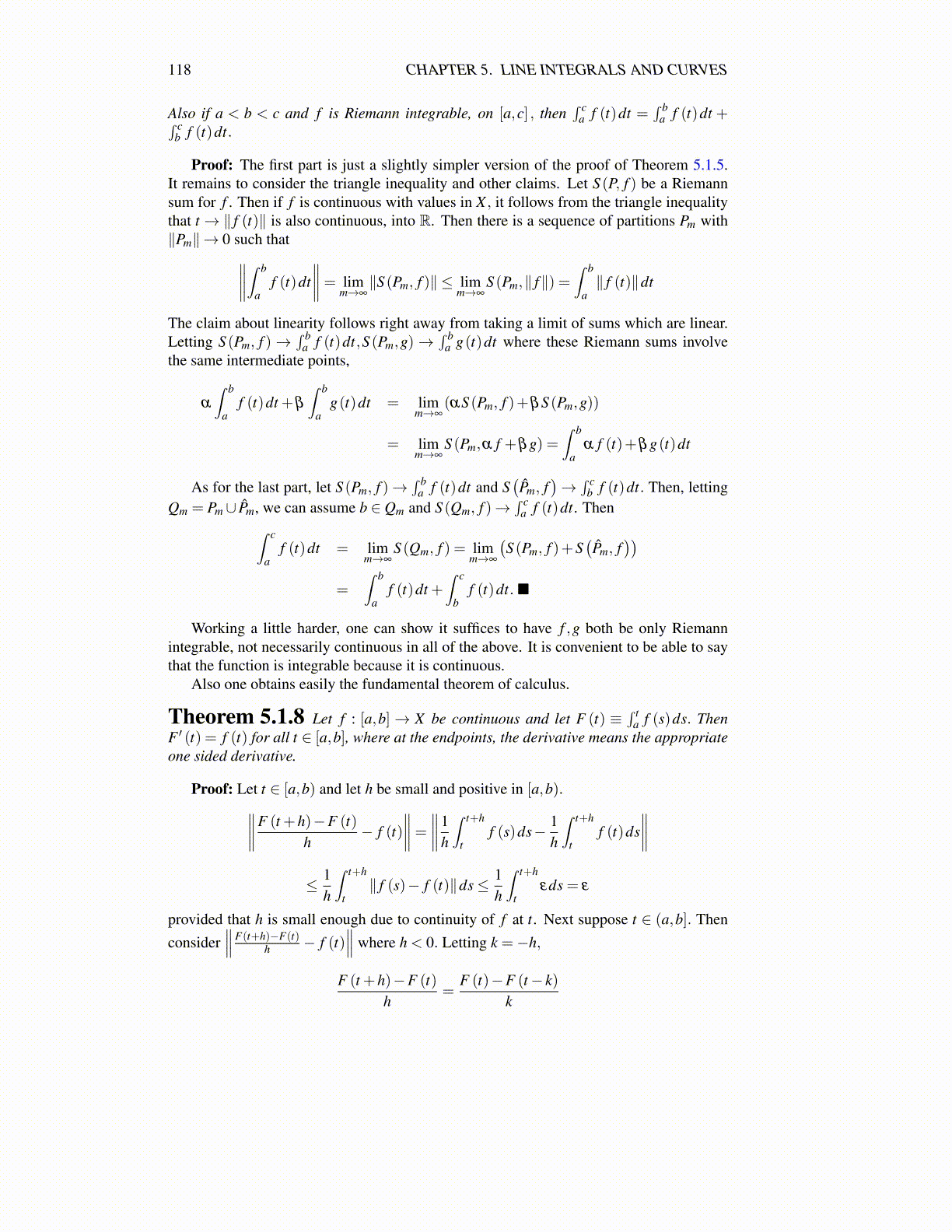
118 CHAPTER 5. LINE INTEGRALS AND CURVES
Also if a < b < c and f is Riemann integrable, on [a,c] , then∫ c
a f (t)dt =∫ b
a f (t)dt +∫ cb f (t)dt.
Proof: The first part is just a slightly simpler version of the proof of Theorem 5.1.5.It remains to consider the triangle inequality and other claims. Let S (P, f ) be a Riemannsum for f . Then if f is continuous with values in X , it follows from the triangle inequalitythat t → ∥ f (t)∥ is also continuous, into R. Then there is a sequence of partitions Pm with∥Pm∥→ 0 such that∥∥∥∥∫ b
af (t)dt
∥∥∥∥= limm→∞∥S (Pm, f )∥ ≤ lim
m→∞S (Pm,∥ f∥) =
∫ b
a∥ f (t)∥dt
The claim about linearity follows right away from taking a limit of sums which are linear.Letting S (Pm, f )→
∫ ba f (t)dt,S (Pm,g)→
∫ ba g(t)dt where these Riemann sums involve
the same intermediate points,
α
∫ b
af (t)dt +β
∫ b
ag(t)dt = lim
m→∞(αS (Pm, f )+βS (Pm,g))
= limm→∞
S (Pm,α f +βg) =∫ b
aα f (t)+βg(t)dt
As for the last part, let S (Pm, f )→∫ b
a f (t)dt and S(P̂m, f
)→∫ c
b f (t)dt. Then, lettingQm = Pm∪ P̂m, we can assume b ∈ Qm and S (Qm, f )→
∫ ca f (t)dt. Then∫ c
af (t)dt = lim
m→∞S (Qm, f ) = lim
m→∞
(S (Pm, f )+S
(P̂m, f
))=
∫ b
af (t)dt +
∫ c
bf (t)dt.■
Working a little harder, one can show it suffices to have f ,g both be only Riemannintegrable, not necessarily continuous in all of the above. It is convenient to be able to saythat the function is integrable because it is continuous.
Also one obtains easily the fundamental theorem of calculus.
Theorem 5.1.8 Let f : [a,b]→ X be continuous and let F (t) ≡∫ t
a f (s)ds. ThenF ′ (t) = f (t) for all t ∈ [a,b], where at the endpoints, the derivative means the appropriateone sided derivative.
Proof: Let t ∈ [a,b) and let h be small and positive in [a,b).∥∥∥∥F (t +h)−F (t)h
− f (t)∥∥∥∥= ∥∥∥∥1
h
∫ t+h
tf (s)ds− 1
h
∫ t+h
tf (t)ds
∥∥∥∥≤ 1
h
∫ t+h
t∥ f (s)− f (t)∥ds≤ 1
h
∫ t+h
tεds = ε
provided that h is small enough due to continuity of f at t. Next suppose t ∈ (a,b]. Thenconsider
∥∥∥F(t+h)−F(t)h − f (t)
∥∥∥ where h < 0. Letting k =−h,
F (t +h)−F (t)h
=F (t)−F (t− k)
k